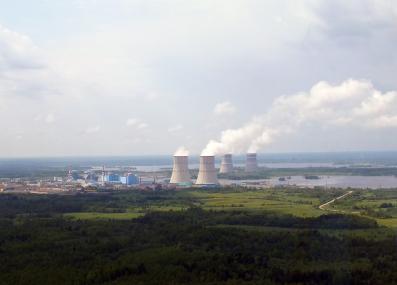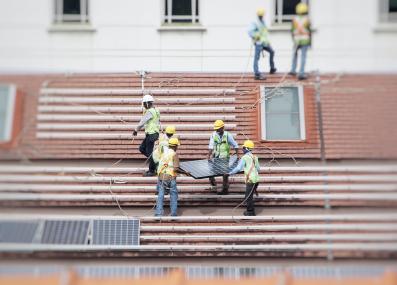New to climate change?
Advanced Nuclear Reactors
Nuclear power plants are a “low-carbon” alternative to fossil fuels that, once built, produce no climate-warming greenhouse gases. And unlike other clean energy sources like wind and solar, nuclear power takes up little space and can run continuously year-round. In 2023, nuclear energy accounted for almost half of the United States' low-carbon electricity.
But this energy comes mostly from power plants whose technology dates back to the 1960s and 70s. These plants are cheap to operate but expensive to build—and new ones are “mega-projects” that take 8 to 10 years to complete. While these older plants have been maintained and upgraded, new designs and alternative fuels are now emerging for the next generation of nuclear reactors. New reactor designs could both speed the transition to a clean energy economy, and serve new purposes that until now have been poor fits for nuclear power.
Moving beyond water
All U.S. nuclear plants use water as their coolant. This water absorbs heat from the reactor and turns it into steam, which spins a turbine and generates electricity.
Some newer designs use alternative coolants like sodium and helium instead. These can operate at higher temperatures than water, so the reactor’s heat can more efficiently be turned into electricity. These designs also make it easier to harness the heat itself, for industrial processes like chemical manufacturing that need a constant supply of high-temperature steam—today normally supplied by climate-warming fossil fuels. China recently launched the first commercial prototype of a design using a helium coolant, which transfers heat from the reactor to a separate heat exchanger to generate steam.
Nuclear energy for storage
Because nuclear plants never need to turn off, they’re a good complement to solar panels and wind turbines, which can only make as much energy as the weather allows. To address this “intermittency,” nuclear power plants can be paired with energy storage to save part of their electricity output for times when the supply of wind and solar energy is low. In fact, many nuclear plants are already paired with storage today, because they are most efficient when they run around the clock—even through the night when there’s less demand on the electric grid. Most often, nuclear is paired with “pumped hydropower,” using spare electricity to pump water uphill so it can later be released through a hydroelectric dam.
New nuclear designs under development use a different form of storage that takes advantage of their high heat output: molten salt tanks. These tanks can hold heat from the reactor for days, converting it to extra electricity when needed. With molten salt storage, a nuclear plant can run at full power constantly and still produce variable electricity, which is good for its economics and the stability of the electric grid.
Scaling down
A typical nuclear plant today makes over 1000 megawatts (MW) of electricity—enough to power a midsize city. But setting up a plant like this is a huge investment of time and money, and usually requires a custom design.
The next generation of nuclear power will feature smaller reactors. “Small modular reactors” have outputs of between 5 and 400 MW. Even smaller than these are microreactors or “nuclear batteries,” which private companies and the U.S. military are designing to supply just a few megawatts of power to places like remote mines and military bases, which do not have access to the electric grid.
The smaller the reactor, the more it can take advantage of mass production. The goal is for some future reactors to be factory-manufactured, transported easily, and installed quickly, all important cost-saving measures. Microreactors and small modular reactors could also be installed incrementally, one reactor at a time, much like wind and solar power. This lowers the investment risk to their owners and helps scale projects to local needs. And with simpler designs, more of their controls and safety measures can be automated, unlike traditional power plants that need large staffs.
Alternative fuels
Nuclear power has historically been very safe. Nonetheless, because of the risk of radiation leaks, power plants have rarely been co-located with energy consumers like chemical facilities, university campuses, or residential areas.
Small modular reactors could help bring nuclear energy directly to where it’s needed, as smaller power plants create less radioactive material. But engineers are also working on accident-tolerant fuels that will further reduce risks. One promising fuel is TRISO (tri-structural isotropic particles), a tiny ceramic sphere containing just a cubic millimeter of uranium. Breaking the uranium fuel into tiny, isolated particles can contain radiation within the reactor and minimize the risk of meltdowns.
These novel fuels require higher levels of uranium enrichment—not so high as to pose a risk for nuclear weapons proliferation, but higher than current U.S. regulations allow for commercial enrichment, fabrication and transportation. New regulation is needed to roll these fuels out commercially.
Today, the U.S. is investing in all these next-generation designs. Legislation since 2022 has provided billions of dollars for research and development of new nuclear technologies, and given nuclear plants the same tax benefits as clean solar and wind power. And in 2024, the ADVANCE Act was passed with large, bipartisan majorities to reform the way the Nuclear Regulatory Commission reviews new nuclear technologies and power plants, to lower costs and speed approvals.
July 30, 2024









